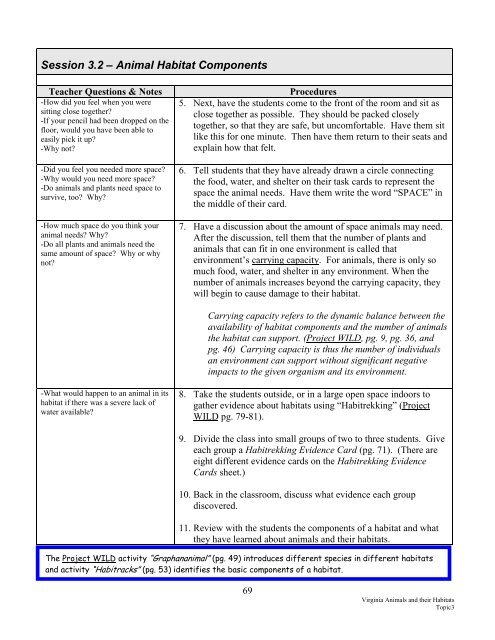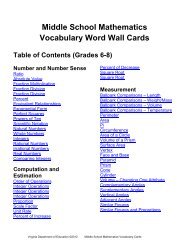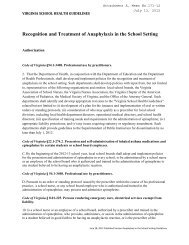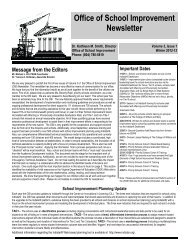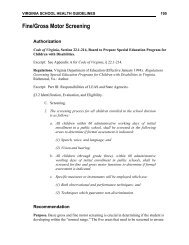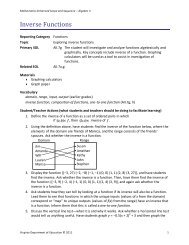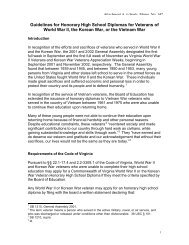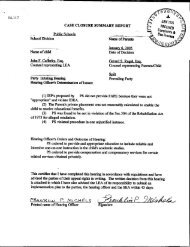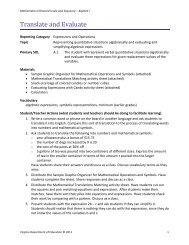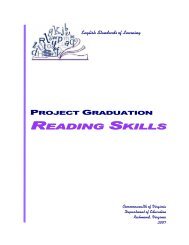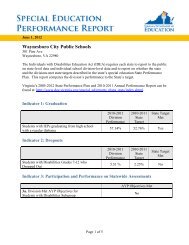What Makes Something Alive - Virginia Department of Education
What Makes Something Alive - Virginia Department of Education
What Makes Something Alive - Virginia Department of Education
You also want an ePaper? Increase the reach of your titles
YUMPU automatically turns print PDFs into web optimized ePapers that Google loves.
Session 3.2 – Animal Habitat Components<br />
Teacher Questions & Notes<br />
-How did you feel when you were<br />
sitting close together?<br />
-If your pencil had been dropped on the<br />
floor, would you have been able to<br />
easily pick it up?<br />
-Why not?<br />
-Did you feel you needed more space?<br />
-Why would you need more space?<br />
-Do animals and plants need space to<br />
survive, too? Why?<br />
-How much space do you think your<br />
animal needs? Why?<br />
-Do all plants and animals need the<br />
same amount <strong>of</strong> space? Why or why<br />
not?<br />
Procedures<br />
5. Next, have the students come to the front <strong>of</strong> the room and sit as<br />
close together as possible. They should be packed closely<br />
together, so that they are safe, but uncomfortable. Have them sit<br />
like this for one minute. Then have them return to their seats and<br />
explain how that felt.<br />
6. Tell students that they have already drawn a circle connecting<br />
the food, water, and shelter on their task cards to represent the<br />
space the animal needs. Have them write the word “SPACE” in<br />
the middle <strong>of</strong> their card.<br />
7. Have a discussion about the amount <strong>of</strong> space animals may need.<br />
After the discussion, tell them that the number <strong>of</strong> plants and<br />
animals that can fit in one environment is called that<br />
environment‟s carrying capacity. For animals, there is only so<br />
much food, water, and shelter in any environment. When the<br />
number <strong>of</strong> animals increases beyond the carrying capacity, they<br />
will begin to cause damage to their habitat.<br />
Carrying capacity refers to the dynamic balance between the<br />
availability <strong>of</strong> habitat components and the number <strong>of</strong> animals<br />
the habitat can support. (Project WILD, pg. 9, pg. 36, and<br />
pg. 46) Carrying capacity is thus the number <strong>of</strong> individuals<br />
an environment can support without significant negative<br />
impacts to the given organism and its environment.<br />
-<strong>What</strong> would happen to an animal in its<br />
habitat if there was a severe lack <strong>of</strong><br />
water available?<br />
8. Take the students outside, or in a large open space indoors to<br />
gather evidence about habitats using “Habitrekking” (Project<br />
WILD pg. 79-81).<br />
9. Divide the class into small groups <strong>of</strong> two to three students. Give<br />
each group a Habitrekking Evidence Card (pg. 71). (There are<br />
eight different evidence cards on the Habitrekking Evidence<br />
Cards sheet.)<br />
10. Back in the classroom, discuss what evidence each group<br />
discovered.<br />
11. Review with the students the components <strong>of</strong> a habitat and what<br />
they have learned about animals and their habitats.<br />
The Project WILD activity “Graphananimal” (pg. 49) introduces different species in different habitats<br />
and activity “Habitracks” (pg. 53) identifies the basic components <strong>of</strong> a habitat.<br />
69<br />
<strong>Virginia</strong> Animals and their Habitats<br />
Topic3


